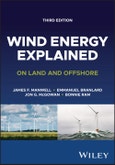Wind Energy Explained provides complete and comprehensive coverage on the topic of wind energy, starting with general concepts like the history of and rationale for wind energy and continuing into specific technological components and applications along with the new recent developments in the field.
Divided into 16 chapters, this edition includes up-to-date data, diagrams, and illustrations, boasting an impressive 35% new material including new sections on metocean design conditions, wind turbine design, wind power plants and the electrical system, fixed and floating offshore wind turbines, project development, permitting and environmental risks and benefits, turbine installation, operation and maintenance, and high penetration wind energy systems and power-to-X.
Wind Energy Explained also includes information on: - Modern wind turbines, covering the design and their many components such as the rotor, drive train, and generator - Aerodynamics of wind energy, covering one-dimensional momentum theory, the Betz limit, and ideal horizontal axis wind turbine with wake rotation - Environmental external design conditions, such as wind, waves, currents, tides, salinity, floating ice, and many more - Commonly used materials and components, such as steel, composites, copper, and concrete, plus machinery elements, such as shafts, couplings, bearings, and gears - Modern design methods, including probabilistic design - Environmental effects and mitigation strategies for wind project siting and the role of public engagement in the development process
This book offers a complete examination of one of the most promising sources of renewable energy and is a great introduction to this cross-disciplinary field for practicing engineers. It may also be used as a textbook resource for university level courses in wind energy, both introductory and advanced.
Table of Contents
About the Authors xxxii
Preface xxxiii
Acknowledgments xxxv
1 Introduction: Modern Wind Energy and Its Origins 1
2 Wind Characteristics and Resources 25
3 Aerodynamics of Wind Turbines 71
4 Mechanics and Dynamics 153
5 Electrical Aspects of Wind Turbines 205
6 Environmental External Design Conditions 251
7 Wind Turbine Materials and Components of the Rotor Nacelle Assembly 295
8 Wind Turbine Design and Testing 343
9 Wind Turbine Control 395
10 Soils, Foundations, and Fixed Support Structures 435
11 Floating Offshore Wind Turbines 467
12 Wind Farms and Wind Power Plants 511
13 Wind Energy System Economics 551
14 Project Development, Permitting, Environmental Considerations, and Public Engagement 589
15 Installation, Operation, and Maintenance of Wind Turbines 643
16 Wind-Generated Energy: Present Use and Future Potential 685
Appendix A Nomenclature 725
Appendix B Data Analysis and Data Synthesis 765
Appendix C Notes on Probability Distributions 779
Appendix D Properties of Fundamental Support Structure Components 791
Appendix E Information Regarding Problems and Associated Files 793
Index 795








